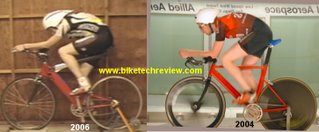Cycling Weekly e-Interview - part 1
A few months ago, I was sent a series of questions from Oliver Roberts of Cycling Weekly over in the UK.
I spent a wee-bit of time answering all of the questions he sent my way, and some of those answers made it into the final publication (which was cool to see!) - although, I had to purchase a digital copy of it to check out if I was quoted well! ;0)
http://www.zinio.com/cover?is=228905657&img=l
Anyway, since I took the time to answer the questions for him - I reckon my answers would make for some good fodder here on kdublog - I've added some additional nuggets where I felt like it, FWIW!
here goes - question #1:
[cycling weekly] "The received wisdom is 'as low as possible is better' is this in fact the case?"
[kraig] I don’t think so.
I’m living proof that lower is not necessarily better. For the better part of 15 years of bike racing my TT setup was such that I made the bars as low as possible. Then, I went to the Wind Tunnel here in San Diego (http://www.lswt.com/) and explored what I call the "design space".
I quantified how much my axial force changed as a function of reach, drop, elbow width, forearm angle, saddle position, etc… over several different tunnel sessions. What I found out was that I had been riding below my potential in flat TT’s, largely in pursuit of becoming as "aerodynamic" as possible.
Last year (2006), I set lifetime personal bests at the 20k distance with a bar position that was 10+cm higher than previous positions - simply because I intelligently used the tools at my disposal to measure both axial force (I used a wind tunnel) and power production (I used an SRM Pro Power Meter). I also re-learned how to surf the pain curve during the actual time trials - that's worth quite a bit of time, I reckon!
Here's a photo comparison of my position in 2004 vs 2006:

Sure, going lower will generally make you more aerodynamic (that’s why folks tuck on descents!), but at what cost to the other parameter - power production? Going fast is a balance of one’s axial force, power production, and most importantly, putting it all together and executing via the supercomputer on race day.
Here’s an article I wrote that tries to send the message that using tools to help guide the positioning process is often times helpful:
http://www.biketechreview.com/performance/faster.htm
I spent a wee-bit of time answering all of the questions he sent my way, and some of those answers made it into the final publication (which was cool to see!) - although, I had to purchase a digital copy of it to check out if I was quoted well! ;0)
http://www.zinio.com/cover?is=228905657&img=l
Anyway, since I took the time to answer the questions for him - I reckon my answers would make for some good fodder here on kdublog - I've added some additional nuggets where I felt like it, FWIW!
here goes - question #1:
[cycling weekly] "The received wisdom is 'as low as possible is better' is this in fact the case?"
[kraig] I don’t think so.
I’m living proof that lower is not necessarily better. For the better part of 15 years of bike racing my TT setup was such that I made the bars as low as possible. Then, I went to the Wind Tunnel here in San Diego (http://www.lswt.com/) and explored what I call the "design space".
I quantified how much my axial force changed as a function of reach, drop, elbow width, forearm angle, saddle position, etc… over several different tunnel sessions. What I found out was that I had been riding below my potential in flat TT’s, largely in pursuit of becoming as "aerodynamic" as possible.
Last year (2006), I set lifetime personal bests at the 20k distance with a bar position that was 10+cm higher than previous positions - simply because I intelligently used the tools at my disposal to measure both axial force (I used a wind tunnel) and power production (I used an SRM Pro Power Meter). I also re-learned how to surf the pain curve during the actual time trials - that's worth quite a bit of time, I reckon!
Here's a photo comparison of my position in 2004 vs 2006:

Sure, going lower will generally make you more aerodynamic (that’s why folks tuck on descents!), but at what cost to the other parameter - power production? Going fast is a balance of one’s axial force, power production, and most importantly, putting it all together and executing via the supercomputer on race day.
Here’s an article I wrote that tries to send the message that using tools to help guide the positioning process is often times helpful:
http://www.biketechreview.com/performance/faster.htm
Labels: cycling weekly, Faster is Faster, TT Position, Wind Tunnel



0 Comments:
Post a Comment
Links to this post:
Create a Link
<< Home